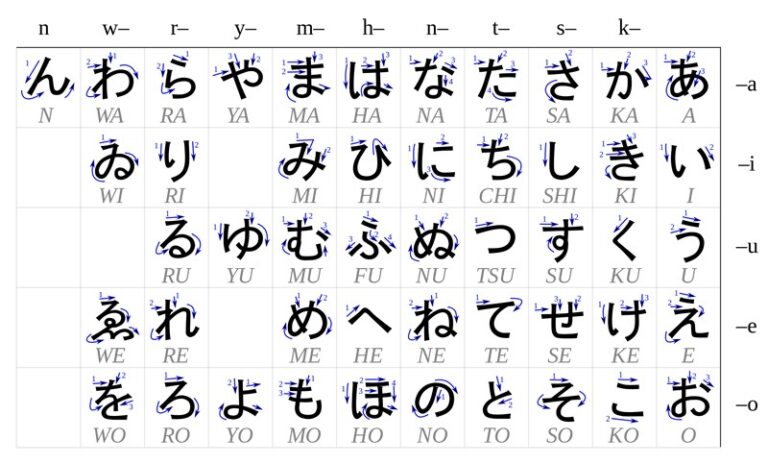Learning Japanese is on the to-do list of many Japan lovers. But what’s the best way to start? And how much should you know? For comparison: a Japanese elementary school student learns 80 kanji characters in the first year, by the end of elementary school he has mastered about 1000 kanji, by the end of middle school (9th grade) there are about 2100. In addition, there are 46 hiragana and katakana characters each, and of course Japanese grammar is also taught. Sounds quite a lot and complicated? A glance at a Japanese book or a Japanese daily newspaper like the Yomiuri Shimbun seems to confirm this assumption. But if you understand how the Japanese language and the Japanese characters were created and with the right learning approach, learning Japanese is not that difficult anymore.
Hiragana, Katakana, Kanji – Understanding Japanese character systems
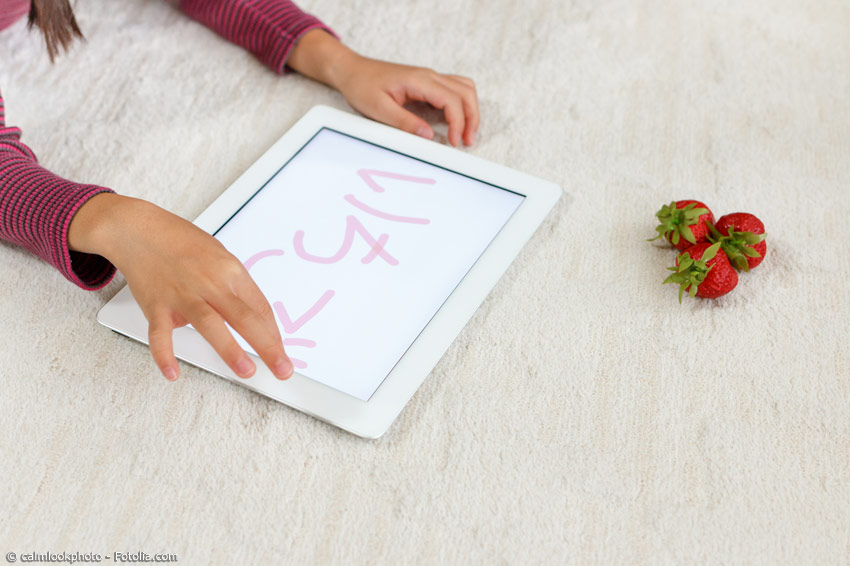 Hiragana are the simplest writing system in Japanese. Japanese elementary school students and international students of Japanese learn them first. – Image: © calmlookphoto – fotolia.com
Hiragana are the simplest writing system in Japanese. Japanese elementary school students and international students of Japanese learn them first. – Image: © calmlookphoto – fotolia.com
There are four different character systems in Japanese.In addition to our familiar Latin letters, which are called “Romaji” in Japan, there are the three main writing systems of the Japanese language, which are divided into “Kanji” (漢字, Chinese characters) and “Kana” (仮名, syllables). Each character – regardless of which writing system it is – has a fixed stroke order, i.e. the sequence and direction in which the individual strokes are written. This is not only important in calligraphy – the artistic art of writing – but also in everyday Japanese life. The following writing systems are distinguished:
- Hiragana: These 46 characters are the simplest Japanese syllabary. They have a round and soft appearance and are the first characters taught in Japanese elementary schools as well as in Japanese classes outside Japan. In addition to the 46 basic characters, there are two accented characters that turn a “ha” (は) into a “ba” (ば) or a “pa” (ぱ), for example, as well as combinations of the characters of the i-series and the characters of the y-series (example: shi しand ya や become sha しゃ). Hiragana are used for grammatical constructions (for example, in the conjugation of verbs or to indicate subjects) or as a phonetic transcription for kanji, so that they serve as a reading aid. In the latter case, the hiragana characters are written in small letters above or to the right of the corresponding kanji and referred to as “furigana”.
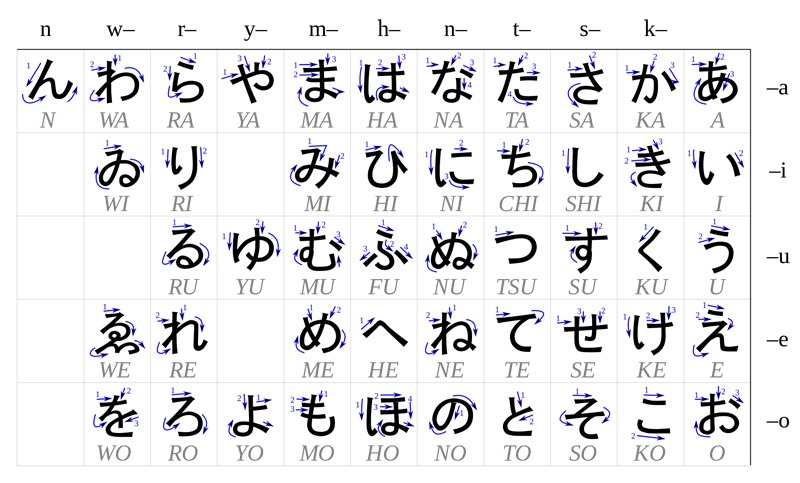 Hiragana is a Japanese syllabic script with 46 different basic characters that play an important role in Japanese grammar.
Hiragana is a Japanese syllabic script with 46 different basic characters that play an important role in Japanese grammar.
- Katakana: These 46 characters are also a Japanese syllabic script. They appear much more angular and straight than the hiragana characters. Katakana are mainly used for the phonetic transcription of foreign words. Mostly they stand alone, sometimes they can be found in small letters above or next to a foreign term in Latin letters to make it easier for the Japanese to pronounce the foreign word. Here, too, there are the same combinations and stress characters as in the hiragana, in order to be able to represent words like “Japanese” (ジャパニーズ) with the katakana characters.
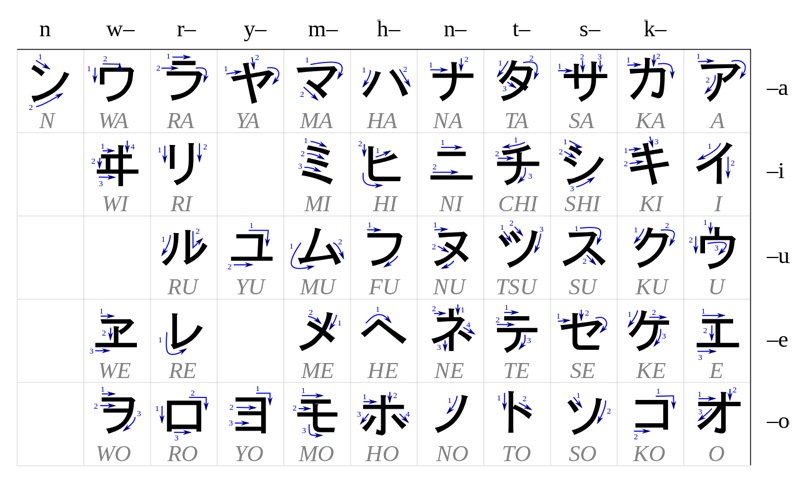 Katakana is a Japanese syllabic script with 46 different basic characters, which are mainly used for foreign terms.
Katakana is a Japanese syllabic script with 46 different basic characters, which are mainly used for foreign terms. - Kanji: These are the characters used for nouns, names, places, and the stems of verbs and adjectives. At the same time, kanji are the character system that often causes the greatest problems when learning Japanese. Many people shy away from the sheer number and complexity. In the Dai Kan-Wa Jiten, the large Kanji dictionary, a whole 50,000 Kanji are listed. In everyday use, however, “only” between 4,000 and 13,000 characters are necessary to understand texts, educated Japanese know about 5,000 characters. In everyday life and especially at the beginning of the learning process, a much smaller number of Japanese kanji is sufficient. Kanji are distinguished by their “components”, called radicals. In many overview tables and dictionaries, you will find kanji sorted by the number of strokes or radicals.
Contrary to popular belief, not all kanji were adopted from Chinese. It is true that Japan adopted the written language from Chinese in the 3rd/4th century AD, but this does not apply to all characters. There are also kanji that were developed in Japan (called “kokuji”) as well as the hiragana and katakana. Regardless, kanji characters have changed over the centuries, being simplified and adapted. This process also occurred in China and other countries, but independently, so that many Japanese and Chinese characters are now completely different from each other, both in representation and in reading.
The Japanese language and its stumbling blocks
 Japanese grammar is only one of the stumbling blocks in learning Japanese. As usual in Japanese, it’s all in the details. – Image: © taka – fotolia.com
Japanese grammar is only one of the stumbling blocks in learning Japanese. As usual in Japanese, it’s all in the details. – Image: © taka – fotolia.com
It is also due to the adoption of Chinese characters that kanji in Japanese have two different readings: The On reading and the Kun reading. Those who have just started learning Japanese are sometimes confused as to why the 1 (Japanese kanji 一) is pronounced “ichi” (一, one) one time and “hitotsu” (一つ, once/a piece) another time.
The On reading is the Sino-Japanese reading of kanji, that is, the reading that the Japanese adopted from China. The Kun reading is the Old Japanese reading when a Japanese word was mapped to a Chinese character. Each kanji has one on reading (sometimes two) and two to five kun readings. When learning Japanese, this often causes confusion about the correct reading of the word. A tip: If the kanji stands alone or the word is formed from a kanji and a following kanji, one usually uses the on reading; if the kanji is followed by a hiragana, one usually uses the kun reading – as in the above example with “one” (on reading: ichi, kun reading hitotsu).
Another stumbling block is Japanese grammar: the conjugation of Japanese verbs seems complicated. There are only two irregular verbs in the Japanese language – “suru” (する, to do) and “kuru” (くる, to come) – and “desu” (です, to be) as an auxiliary verb. All other verbs are either ichidan verbs or godan verbs.
- Ichidan verbs have only one form. They keep their root when inflected and only change their ending. If a verb ends in “iru” or “eru”, 99% of the time it is an Ichidan verb.
Example: “miru” (みる, see) is an “iru” verb, “taberu” (たべる, eat) is an “eru” verb. If you form the past tense, they become “mita” (みた, saw) and “tabeta” (たべた, ate), the root words “mi-” and “tabe-” remain in each verb form.
- Godan verbs have five forms. They change their root when inflected, depending on the verb form, the last syllable of the root of these verbs shifts from “u” to “a”, “i”, “e” or “o”.
For example, “kiku” (きく, to hear) changes to “kikitai” (ききたい, to want to hear), so there is a shift from “ku” to “ki”.
For some forms, like the past tense, what matters is which syllable the Godan verb ends on, because there is no simple sound shift there.
For example, “au” (あう, meet) ends in “u” and becomes “atta” (あった, met) in the past tense, while “kiku” (きく, hear) ends in “ku” and becomes “kiita” (きいた, heard).
In addition, there are a handful of verbs that end in “eru” or “iru” but are not Ichidan verbs – these should be memorized in order to inflect them correctly.
Politeness in Japan is a complicated construct – there are different levels of politeness, from the very respectful Keigo to polite Japanese and standard Japanese to street slang. In between, there are countless nuances. Most Japanese lessons focus on standard Japanese (taberu, eat) and polite Japanese with -masu (tabemasu, eat); both are usually quite sufficient.
By the way, there are many ways to say “I” or “you” in Japanese. Depending on the level of politeness and who the speaker and addressee are. In addition, there are countless name suffixes that are added to a person’s first or last name – depending on the relationship or rank of the person. In addition to the well-known, neutral “-san”, there are other suffixes that can be very respectful (“-sama”), belittling (“-chan”, “-pon”) or related to the profession of the other person (“-sensei”). However, you can’t go wrong with “-san” appended to the last name.
Last but not least, a stumbling block that should be familiar to anime fans in particular: Japanese dialects. The best known is probably “Osaka-ben”, the dialect spoken in Osaka and the surrounding area. It sounds a bit rude and direct – it can probably be compared most closely to the Berlin dialect in Germany. From the High Japanese “Baka desu ka?!” (Are you stupid?!) becomes “Aho ya nen?!” in Osaka-ben. This example illustrates that in Japanese, just as in German, there are locally very large differences in the everyday spoken language; in some cases, completely different words are used. Japanese dialects – especially when used by foreigners – are often perceived as rude or unintentionally amusing, one is quickly smiled at or in the worst case gets the cold shoulder. Therefore, when learning Japanese, you should definitely concentrate on High Japanese.
Learn Japanese – how to do it right?
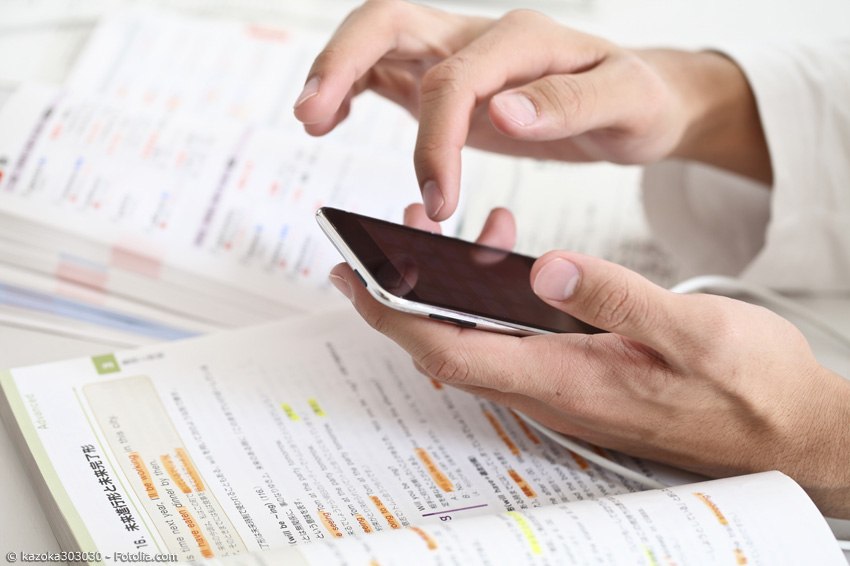 You can learn Japanese in a number of ways, for example as a course at a language centre, self-study via an app or at a university. – Image: © kazoka3030 – fotolia.com
You can learn Japanese in a number of ways, for example as a course at a language centre, self-study via an app or at a university. – Image: © kazoka3030 – fotolia.com
The stumbling blocks of the Japanese language can seem daunting at first. But if we look at the English language in comparison, we use, for example, many more different verb forms, articles and plural forms (both do not exist in Japanese), as well as complicated grammatical constructions and character rules. The only hurdle to overcome first when learning Japanese is learning the first character system, the hiragana. Japanese beginners often learn vocabulary and grammar without kana and kanji until they have mastered the first Japanese syllable signs and kanji. But what is the best way to learn Japanese? In self-study or in language courses? Online, offline or via app? We present some alternatives.
Japanese Language School
Toranomon Language School offers Japanese language courses. Depending on your learning progress, you can choose an appropriate course from beginner to advanced level. You will receive systematic and high quality lessons by experienced and methodical instructors.
For more information, click here. Universities, language centres and adult education centres offer different courses that cater for different language levels. Learning methods and group sizes differ. – Image: © desert – fotolia.com
Universities, language centres and adult education centres offer different courses that cater for different language levels. Learning methods and group sizes differ. – Image: © desert – fotolia.com
Learn Japanese App: Kawaii Nihongoand Human Japanese
Why do without tablets and smartphones as a self-learner in the digital age? Nowadays, you don’t necessarily need Japanese books to learn – even though they are still a good basis and can be extremely helpful especially when studying for the JLPT exams. In the modern age, however, there are other ways. A Japanese learning app like Kawaii Nihongo or Human Japanese facilitates the access to this language and illustrates the learning content in different ways.
Kawaii Nihongo (kawaii日本語) is an app for iOS and Android that aims to make learning Japanese easier and more accessible. The app is primarily aimed at Japanese beginners who want to learn hiragana and katakana. Once you have the character systems down, you can also use the Kawaii Nihongo app to learn selected vocabulary for the JLPT N5 test (the lowest level of language certification for Japanese). Future updates to the app are expected to include an extension for kanji and Japanese grammar. If you like anime and manga, you will love this app because to enhance the learning effect of each flashcard, there are cute motif drawings for each character or vocabulary. This way you can build mnemonic bridges and increase the recognition value.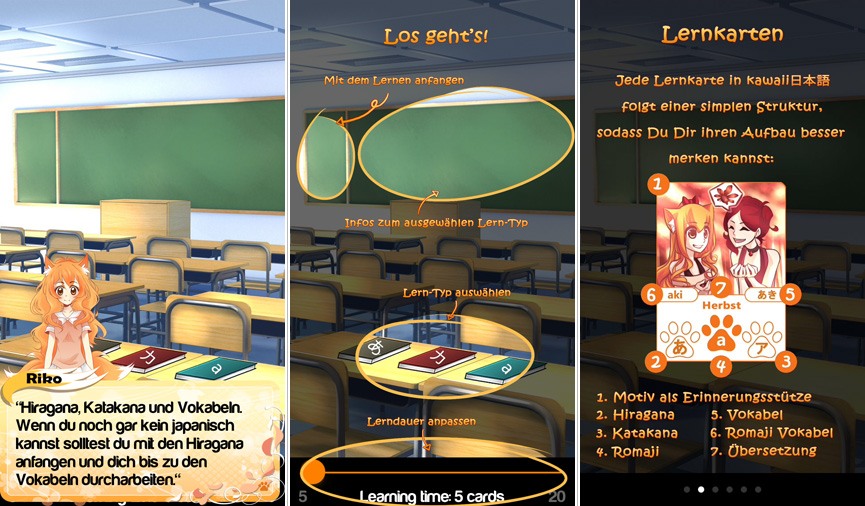 Kawaii Nihongo is an app that makes learning hiragana, katakana and vocabulary fun. The cute flashcards make learning easier with matching illustrations.
Kawaii Nihongo is an app that makes learning hiragana, katakana and vocabulary fun. The cute flashcards make learning easier with matching illustrations.
After installing the kawaii日本語 app, you are welcomed by the characters of the app and led to the school. In the “teacher’s room” you are given all the “books”, which are the app’s flashcards. Then you find yourself in the classroom, where you can choose the individual lessons: Hiragana, Katakana, or Vocabulary. Navigating the app is easy. The little fox girl Riko accompanies the Japanese learner all the time, explaining the functions or inviting you to play games. Since the app is set up like a simplified city with a school, an arcade, and a temple, there are little stories and lots of places to go to reinforce what you’ve learned. Plus, Riko the fox girl is a cute companion to guide you through all levels of the app. The loving, colorful design of the Kawaii Nihongo app is primarily designed for a young and youthful target group that is just discovering the Japanese language for themselves (primarily through anime and manga), and convinces with its playful character and the appealing story.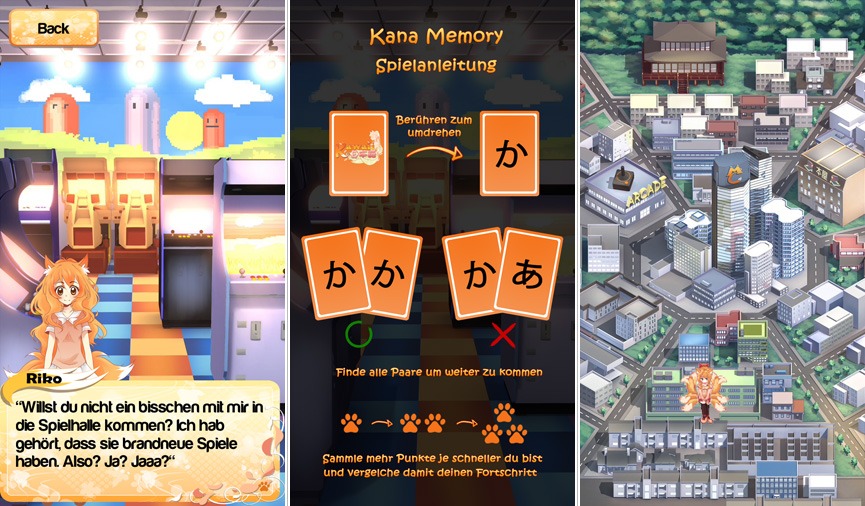 Games in the app Kawaii Nihongo can be used to consolidate what has been learned. But there is more to discover in the learning environment, which is designed like a city.
Games in the app Kawaii Nihongo can be used to consolidate what has been learned. But there is more to discover in the learning environment, which is designed like a city.
For 2.99 euros, you can get the Kawaii Nihongo app in the AppStore and Google Play – or for free for the winners of our current competition (participation period from 28 June to 10 July 2016). Older and/or advanced learners will certainly find a good alternative with the next app.
Human Japanese is a comprehensive app that leaves hardly any wish unfulfilled in terms of learning Japanese. However, it must be said in advance that the app and thus all learning content is only available in English. Those who have a good command of the English language should have no problems with the Japanese learning app from Human Japanese. This app offers a solid learning basis for Japanese beginners as well as for advanced learners. Individual chapters teach Japanese characters (kana and kanji), vocabulary, Japanese grammar, and structures. But that’s not all. In the thematically subdivided chapters, there is a lot of background knowledge about Japanese culture and language, as well as explanations of grammatical constructions, kanji learned, and dialogues presented. Many example sentences and animations of hiragana, katakana and kanji round off the course. Vocabulary chapters alternate with grammar chapters and character chapters. In addition, there are audio examples of Japanese native speakers for every vocabulary word and every dialogue. In this way, listening comprehension and correct pronunciation can be practiced by repeating the words.
The app is available in four different versions: Human Japanese (€9.99 or €8.04) with 42 chapters for beginners and intermediate learners, Human Japanese Intermediate (€9.99 or €8.06) with 42 new chapters for advanced learners, and the free Human Japanese Lite app and the free Human Japanese Intermediate Lite app with the complete first eight chapters of each paid version. Attention Apple users: there are separate apps for iPad and Mac, which are higher priced. Again, each has free lite versions with the first eight chapters. All apps are available in the AppStore and on Google Play.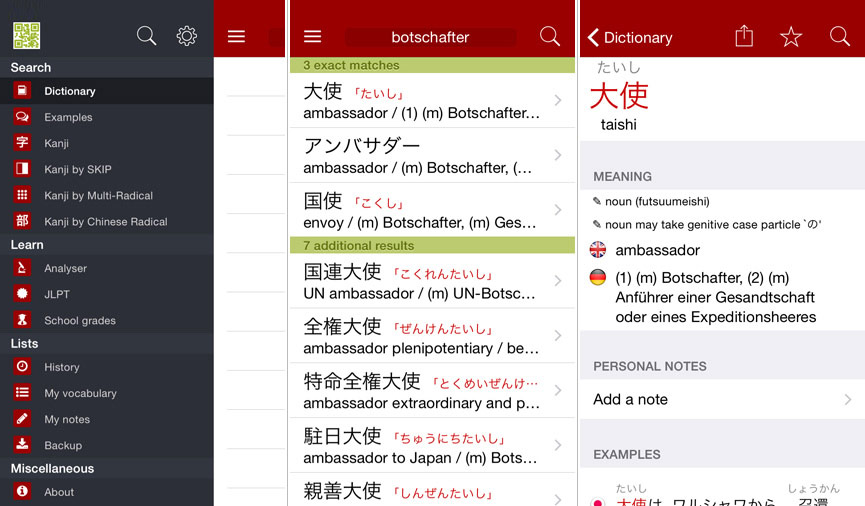 Imiwa? is a feature-rich Japanese dictionary for iOS. The app JED – Japanese Dictionary is the equivalent for Android.
Imiwa? is a feature-rich Japanese dictionary for iOS. The app JED – Japanese Dictionary is the equivalent for Android.
To help you learn Japanese, you need dictionaries. There are two very good free dictionaries on the app market that can do even more than simply translate a search term. imiwa? for iOS and JED – Japanese Dictionary for Android work in the same way and offer other functions in addition to translating search terms: The display of the reading/kanji and whether the word is in common use; a listing of examples and explanations; verb conjugations and mnemonic functions. But that’s not all. Kanji can be searched by typing or by their composites – JED even allows you to draw the kanji by hand followed by a search. And if you stumble across a sentence you don’t understand on the Internet or while chatting with Japanese friends, simply copy and paste it into the Analyzer – it immediately provides a word-for-word translation of the content as well as the corresponding reading of the words.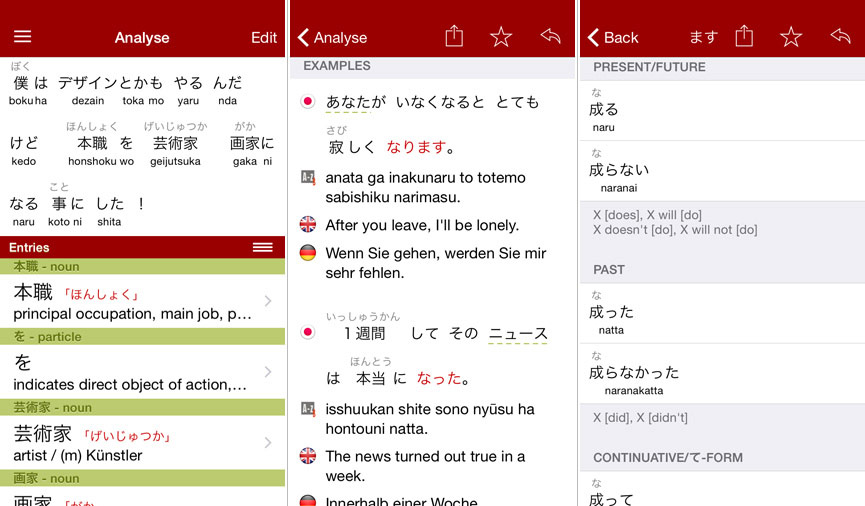 With imiwa? and JED, not only can individual words be looked up, the apps also offer verb conjugations, examples and analyses of existing text.
With imiwa? and JED, not only can individual words be looked up, the apps also offer verb conjugations, examples and analyses of existing text.
Conclusion: Find the right method and practice!
The only important thing is that Japanese beginners do not try to learn everything at once. The key to success in learning Japanese is in any case: practice! The more often you write the characters and cram vocabulary and grammar, the faster your knowledge will be consolidated and the more confident you will become in using it. You should pay attention to details, so that no mistakes creep in, which are also consolidated in the repetition – which can happen quickly especially in self-study due to the lack of correction by a teacher. A Japanese tandem partner (i.e. a Japanese native speaker who wants to learn German in return) is not only a good idea for self-study. This person provides sufficient practice through conversation and can correct mistakes if necessary.
All in all, learning Japanese has become much easier thanks to the internet and apps like Kawaii Nihongo or Human Japanese than it was just a few years ago. If you want to study the language intensively and possibly even work towards one of the language certificates, there is no getting around a lot of practice and regular, concentrated learning. Although much can be learned through self-study, well-organized courses at language centers or universities with appropriate learning materials remain the better alternative. Those who aspire to professions in Japan or with a strong Japanese connection are still well advised to study Japanese Studies or a comparable course. But not everyone wants to become a Japanese professional – for some, it is enough to be able to ask for directions on a Japanese holiday or to be able to communicate better with Japanese friends.
Whichever way you choose: There are currently so many good ways to learn Japanese that there is certainly the right method for everyone. The most important thing is to start! In this sense: 日本語を勉強しましょう! (Nihongo o benkyou shimashou!, Let’s learn Japanese!)

